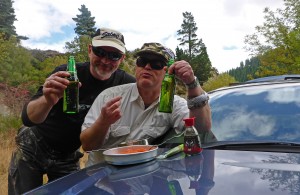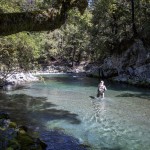New Zealand – The Planet of the Trout
This was one of my greatest angler’s dreams since I became a trout fisherman. I visited the Southern Island with my friends twice – in 2011 and 2014. Despite the fact that a lot of time had passed since my last trip over there, the memories from that country are so vivid that all it takes for me is to close my eyes and I can see myself being taken back again to this magical land.
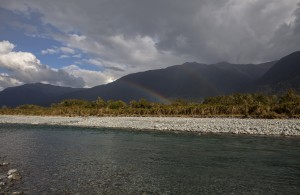
New Zealand is a land so far away from Europe that it seems almost like it is from a fairy tale. Everything over there is strange and slightly different than back home. I constantly had a feeling that I can see things I know but through a crooked mirror. The time difference is 12 hours. That means that our midnight is a high noon in New Zealand. Middle of January over there is a middle of summer. Even the water in the tub when drained twists in the opposite direction (The Coriolis Effect). No wonder then that people and animals also have slightly different customs. Everything over there happens slightly in slow motion and although the local English accent is amazing and impossible to be confused for any other country, people are very friendly and are eager to talk with the tourists. Trout usually feed all day long. However, on a clear, sunny noon they like to “sunbathe” in 25cm shallow water. Strange you might say? Not in New Zealand. In large rivers they swim in circles patrolling the larger pools when searching for food. This behavior is directly linked to the character of the local rivers. Most of them are mountain streams with clear water and gravel or rocky bottoms. The periodical floods wash away all the fallen trees and branches and clear the streams from all the potential hiding spots for fish.
Basically the rivers do not have any other fish than trout and eel. The New Zealand fishing tradition comes straight from the British gentlemen who were strict fly fishermen. Therefore locals usually start their fishing journey not with a bait and bobber or spinning rod but with a fly rod. As a result, their knowledge about lure fishing over there is pretty low. Every river over there has its own regulations but on majority both spinning and fly fishing is allowed. In many places even fishing with natural bait is also permitted.
As far as the trip itself, I can recommend the tactic that in our case worked out pretty well. We would rent a Sport Utility Vehicle and with maps in hand we would plan our fishing excursions basing our knowledge on the info found on the internet and the advice from the locals. This local knowledge turned out to be crucial because some of the local rivers every few years go through a literal Armageddon in the form of torrential spring flood. During that time water can have the color of flowing concrete and the current can be strong enough to move boulders the size of small car! It is a miracle that some fish actually survive this nightmare and after a while the trout population comes back to normal.
During those two trips we were able to explore over a dozen different locations. In my opinion, the best solution is when you have a group of four or six friends with two or three vehicles. It takes a long time for only two anglers to explore new rivers. On the other hand, a large group might pose a logistical problem when trying to divide the fishable waters. It is also worth to mention that there are over 700 trout rivers in Southern Island alone! So there is plenty of water to choose from. Each of our trips was filled with countless adventures and anecdotes which won’t let us sleep in peace for a long time and most likely will force us some day to make a next trip “down under”.
Clean air, beautiful wild mountains, unbelievable landscapes, wilderness and of course those rivers! Majority of them carried water that was just simply so “clear” that it is hard to even describe its color. It was something between turquoise and sapphire mixed in with the dark green of the bush overgrowing the river banks.
It seemed that in this natural aquarium nothing could hide from the sharp eye of the trout angler, at least nothing of decent size. Many times we could observe huge trout waiting in the shallows for the insects. However early morning they would usually hold in the deeper spots where they could perfectly blend in with the river bottom. Then it was impossible to spot them even with the best polarized glasses. But that was only until a perfectly thrown crankbait would land right on the border of shallow and deeper water of the pool. Then sometimes only after 1-2 meters of retrieve a dark torpedo would appear like ghost out of nowhere and crush your lure! It seemed so unreal that only the screaming drag would remind you that it was not a dream.
All trout in New Zealand were introduced in XIX century by British explorers. Glory to them! Since that time, there was no more trout stocking. This means that the trout we were dealing with were wild and spooky fish that lived in those rivers for many generations. Majority of fisheries of the Southern Island are dominated by brown trout. Some rivers also have rainbow trout, and sometimes even salmon- both pacific and atlantic species. All trout have pretty quick growth rates despite the fact that they feed mainly on insects.
You can mainly catch fish over 50 cm long. During both of our trips, we caught only few smaller fish. Majority of them were between 55-65cm. There were few above 70cm. The largest trout that I caught was 73cm long but we saw a few that were a lot bigger! We had few of those behemoths on but we lost them. However the biggest ones would not even be tempted for a single bite.
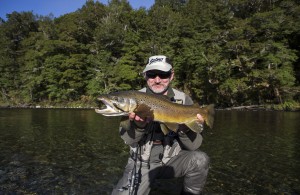
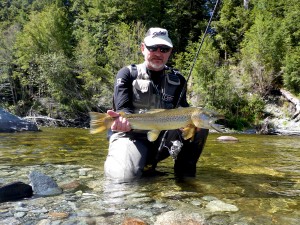
Unfortunately catching trout in majority of the rivers we were fishing was not easy. Just getting close to the river itself was a success on its own. All the roads that lead to the fishing spots go through private properties. On every step there are fences and gates that divide fields into pastures for grazing cattle, sheep and … deer. It is part of a fisherman’s etiquette to ask a landowner for permission to pass through their terrain. That is also what we did anytime we could locate the land owner. Unfortunately often times within many kilometers there were no houses or farm buildings and nobody we could ask to let us through. To make matters even worse some of the gates had a lock on them which is really hard to understand. A lot of the rivers flow through very difficult terrain- deep canyons with almost vertical, rocky cliffs. Their banks are overgrown with thick jungle of brush that is very unfriendly to anything that is soft and can tear. Therefore many times after hour or two of searching for the access to the river we were finally able to find it only to realize that it was impossible to reach it! The only solution was to start our search from the beginning. All of the fishing maps have special “angler’s entry points”. However there are not so many of them and they only allow access to a few hundred meters of the river. Generally we avoided such spots to fish the stretches that were less pressured. We did not meet too many other anglers, although during our second trip we noticed a lot stronger fishing pressure. A lot of the fish we caught hand hook scars. They were also a lot more careful and looked slightly “emaciated”. Therefore it is better to look for smaller streams, forgotten river stretches with difficult access and consult your decisions with the locals. Sometimes even a nice shopkeeper lady in the grocery store can have priceless information because her husband is a fisherman.
Generally trout are everywhere. Even in the smallest streams that flow through small towns. Almost every time when we reached the water or we were observing the river from the bridge, we could see big fish. Sometimes we could even see few of them. It is really hard to describe what happens to the trout angler’s soul when beholding such sights! Of course fish in such places were extra careful because they knew well the taste of the fisherman’s hook. But that does not mean that they were impossible to catch!
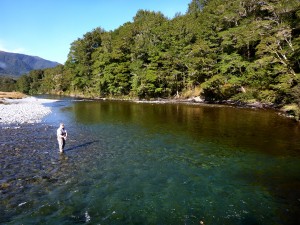
We were mainly using spinning rods with crankbaits. The lure that produced the best was a 7 cm, sinking trout imitation, but the other color versions of this lure also worked well. Unfortunately it was not till the end of our trip till we were finally able to come up with the best tactic. For sure we still will put it to good use in the future. All that we had to do was to keep in mind the unusual trout feeding pattern. First of all, it is necessary to be on the water as early as possible. That was a big problem for us. We would usually get up pretty late, eat breakfast and then start fishing around 9 A.M. The best bites occurred when the sun was still low and high river banks would cast long shadows on the water. So it is crucial to start fishing first thing in the morning. That way you can catch few excellent hours for spin fishing. However it is good to keep your fly rod handy. After 2-3 hours fish would became less aggressive and it would take a lot of effort to make one go after a wobbler. It turned out that the local trout when faced with stronger sunlight and higher temperatures, instead of hiding in the deepest holes like their European counterparts, they would rest in the shallows right next to the bank, sometimes in the water that was only 25cm deep! Most likely only in such spots they could expect a tasty treats in the form of fat grass hoppers or noisy cicadas. A trained eye of the trout angler had no problem with spotting a trout lurking in the shallows. Especially considering the fact that usually those were the fish above 60cm! Then all you had to do was to slowly retreat and throw a small nymph or dry fly imitating something big (like cicada) right in front of the fish. After a hookset, a stunned fish would right away turn into a live torpedo and would force the angler into a wild sprint on slippery rocks! Of course not all of them could be fooled.
There is another thing about rivers in New Zealand that is worth to mention. Basically in all of them there are not that many trout. In order to have your chance you had to walk a pretty good deal. You could not see any small fish anywhere, but basically any good pool or hiding spot was taken by a trophy. On many rivers it meant a lot of long walks between the deeper pools. The smaller streams that cut through the canyons had many holes one after another. We also encountered few rivers that reminded me of my home waters- sandy holes, patches of weed and fallen logs. Over there the numbers of fish were higher. However larger rivers were wide but shallow and would split into many smaller streams. The key thing when fishing in a river valley that was several kilometers wide was to find one of those off shoots or streams that carried the most water. Fishing in the areas around the deepest spots was a recipe for catching big fish. In effect we had to hike 15 to 25 kilometers every day in very difficult terrain. Another fact about the New Zealand trout also came to light- the higher you go up the river, the bigger fish you can encounter. Exactly the opposite of what you might expect in Europe.
At the end of our second trip we decided to visit the famous irrigation channels called McKenzie and Waitaki. Those man-made channels are connecting lakes Ohau, Tekapo and Pukaki and are used to irrigate the local farm land. Few places on those channels have fish farms with salmon and rainbow trout. Every one of those channels also has sizable population of wild trout- both browns and rainbows, and it is because of them those channels are famous among the anglers worldwide. Unfortunately the landscape over there is not that pretty. Honestly- it is worse than just not pretty; it is an eyesore! So what is it that makes fishermen come back over there year after year? It is the size of the trout that swim in those channels. The actual brown trout world record comes right from the Ohau Canal. The fish was caught in March of 2013 and weighted 19.1 kilograms! All it takes is to stop there for a little while to find out that there are more “monsters” of this size swimming in that area. Every year there are many trout caught that weigh over 10 kilograms and whose pictures adorn the walls of reception offices at the campsites. The owner of one of them invited us to check one of the local gas stations and see the trophy trout that was laying there in the fridge. It was a recently caught 17 kg brown trout! After seeing something like that we raced hoping to at least see one of those “mutants” swimming alive in the water. We were not disappointed! Right below the dam in one of the channels, in crystal clear water there was a school of huge trout patrolling the deep pool. We watched them for few hours with our mouths open! There were a lot of fish around 70-80cm. There were few about 1 meter long. However there were at least two that were much longer than 1 meter! To fully gage their size it is necessary to keep in mind their condition and girth. Their gargantuan proportions were unbelievable. This was a result of their diet which in part consists of granular fish feed that spills over from the fish farms. The giants which we saw had the size and a build that of a tuna. Seeing fish like that was an unbelievable experience for every trout fisherman. Unfortunately none of the giants even took a peek on the lures we were throwing. We were able to fool few little ones between 1 and 4 kg. In that sense we were still way better than the locals who would come over and ask us for the name of the lure we were using. The best bait turned out to be sinking Minnow 9 in silver, holographic color. On our last day we were disassembling our rods in heavy rain with mixed feelings. The trip was a success. We had plenty of adventures, feasted our eyes on beautiful sights, and caught plenty of big trout. However the sight of those “submarines” with dots swimming in the Waitaki channels will haunt us until our next trip to New Zealand!


